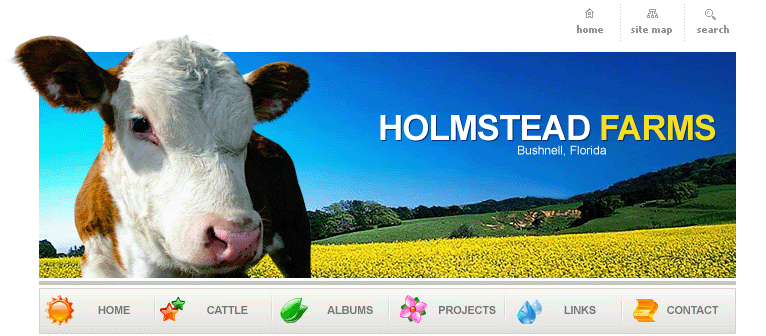Hereford History:
The Hereford breed of beef cattle was established near Hereford, county of Herefordshire, England, nearly 300 years ago as a product of necessity. Thrifty, enterprising British farmers were seeing the need to produce beef for the expanding food market created by Britain's industrial revolution. To successfully meet this growing demand, these early-day cattlemen needed cattle which could efficiently convert native grasses to beef, and do it at a profit.
No breed at that time could fill that need, so the farmers of Herefordshire developed and founded the breed that logically became known as Herefords. These early Hereford breeders molded their cattle with the goals of high beef yields and efficient production. They so solidly fixed these traits that they remain today as outstanding characteristics of the breed. Cattle with the trade-mark white faces and distinctive red bodies are instantly recognized world-wide as a time-tested, reliable source of profitable beef cattle genetics.
Benjamin Tomkins is credited with being a primary founder of the Hereford breed. He began in 1742 with a bull calf from the cow Silver and two cows, Pidgeon and Mottle, inherited from his father's estate. This was 18 years before Robert Bakewell began developing his theories of animal breeding. Tomkins' goals were economy in feeding, natural ability to grow and gain on grass and grain, rustling ability, hardiness, early maturity and high rates of reproduction‹traits that are still of primary importance today.
Other pioneering breeders followed Tomkins' lead and established the world-wide reputation for these Herefordshire cattle, thus causing their exportation from England to wherever grass grows and beef production is possible.
Herefords in the 1700s and early 1800s in England were much larger than today's. Many mature Herefords of those days weighed 3,000 lb. or more when displayed in 1839. Gradually, the type and conformation changed to less extreme size and weight in order to get more quality and efficiency. Today's Herefords are optimum sized to produce slaughter cattle that fit industry demand. weighing in the 1,000 to 1,200-lb. range.
Herefords Take Over:
It was largely through shows and expositions that Herefords gained great acceptance among cattlemen in this country. The first great impact was scored at the 1883 Chicago Fat Stock Show, the forerunner of the famous International Livestock Exposition which, until closing after the 1975 event, was the premier show for market animals in America. At this show more than a century ago, the Hereford steer Roan Boy won the grand championship for his exhibitor, C.M. Culbertson. The steer's early maturity marked the beginning of the end for the previously popular four-year-old steers. In 1886, a two-year-old Hereford was grand champion and in 1903 Hereford yearlings won the carlot grand championship. Three years later, a 336-day-old Hereford won the show, the first ever at less than two years of age.
Thus, Herefords led the way in revolutionizing beef production in America, largely through the traits of doing ability and early maturity‹being market-ready at an early age and producing the ideal in "baby beef." While other traits in beef cattle continued to be important in breeders' selection programs through the ensuing years, there is no doubt that early maturity and finishing ability were of primary concern because (1) the market paid the highest price for cattle that fattened well on forage; thus (2) the preferred breeding animals were those that demonstrated the ability to finish readily at a given age.
To get to this early maturity, breeders in the late 1930s and 1940s sought out the compact type of conformation‹short, low set, wide and deep-bodied cattle‹as their preferred breeding stock. By today's standards, such cattle were naturally smaller. Their success in achieving such an animal with its abundance of fat and establishing that kind as a breed ideal eventually proved to be a detriment. The market changes that surfaced in the 1960s caused such cattle to be penalized in price.
Today's versatile Hereford continues to be the benchmark against which other breeds are measured as cattlemen continue to seek the optimum traits inherent in Herefords. Those traits critical to survival in the cattle business are exactly the same traits Herefords offer to today's industry:
- Fertility
- Reproductive performance
- Optimum size and growth
- Documented feedlot and carcass superiority
- Low maintenance costs
- Optimum muscling
- Optimum milk
- Adaptability and hardiness
- Disposition
- Soundness
- Crossbreeding advantages
For more information please visit the American Hereford Association |

